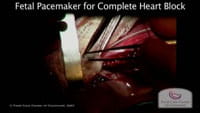Diagnosis
The majority of SCTs are diagnosed in utero. This typically occurs early in the second trimester during a routine ultrasound when a mass can be seen on the baby’s buttocks.
It is at this point that most of our patients affected by SCT are referred to the Cincinnati Children's Fetal Care Center. Here, we’ll work with you to assess the severity of your case, create a plan for the remainder of your pregnancy, and help you understand what to expect after delivery.
These tumors sometimes grow quickly and reach a very large size. In order to grow, the tumor requires a lot of blood flow. As a result, your baby’s heart works hard to pump blood to the tumor. The larger the tumor, the harder the baby’s heart must work.
As the heart increases its output, the baby’s kidneys will also receive more blood flow and consequently make more urine. This increased urine production can lead to excessive amniotic fluid building up inside the uterus. This condition is called polyhydramnios and reflects a progression of the physiologic changes associated with SCT. Polyhydramnios is suspected if your uterus measures larger than it should at a given week in your pregnancy.
In the most severe cases, the tumor can grow so large that the baby’s heart can’t keep up, eventually leading to heart failure in the fetus (hydrops).
Evaluation
We typically see a mother with a fetal SCT within two weeks of her initial diagnosis. Your nurse-coordinator will speak with you and arrange the following tests and meetings during your visit.
- An ultrasound of the baby, where we comprehensively look at the baby and specifically look at the blood supply, size and characteristics of the tumor
- An MRI of the baby, to get more detailed views of the tumor, the baby’s spine and the surrounding structures in the baby’s pelvis
- A fetal echocardiogram, to assess how hard your baby’s heart is working
- A meeting with our social worker to assist with specific needs that you may have
After your tests are complete, our team of experts from maternal-fetal medicine (MFM), pediatric surgery, neonatology, genetics, cardiology and radiology will discuss the results and then meet with you in a team meeting. The important features of the team meeting include:
- Introducing the care team that will be involved both before and after your baby is born
- Reviewing the studies with you that led to the diagnosis and discuss their implications
- Describing the options for prenatal treatment if needed
- Developing a plan for the care of the rest of your pregnancy and the delivery
- Describing the typical evaluation, treatment and long-term outcome for your baby after it is born
Compassionate, Expert Care
The Fetal Care Center offers comprehensive diagnostic tests and the latest treatments for sacrococcygeal teratoma / SCT. Just as important, our team of specialists takes time to explain test results, answer questions and discuss treatment options. We understand that parents are facing unique challenges, and we provide as much support as possible every step of the way. Extensive experience and research allow our team to treat the most complex cases of SCT.
Planning for Delivery
You should deliver in a hospital with a level III neonatal intensive care unit (NICU) available for the specialized medical and surgical care that your baby will require after birth.
For patients who are local or plan to deliver locally, you will deliver at one of our maternity hospitals (University of Cincinnati Medical Center or Good Samaritan Hospital), and your baby will be transferred to the Cincinnati Children’s NICU.
Early delivery is common in pregnancies affected by SCT. Additionally, because of the typically large size and fragile nature of the tumor, in most cases we recommend delivery by cesarean section.






